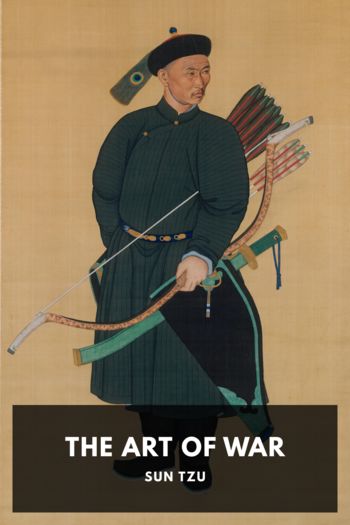The Art of War, Sun Tzu [best english books to read for beginners TXT] 📗

- Author: Sun Tzu
Book online «The Art of War, Sun Tzu [best english books to read for beginners TXT] 📗». Author Sun Tzu
Tu Yu is right, I think, in attributing this force to 角; Tsʽao Kung defines it simply as 量. Capt. Calthrop surpasses himself with the staggering translation “Flap the wings”! Can the Latin cornu (in its figurative sense) have been at the back of his mind? ↩
Cf. chapter IV. (“Standing on the defensive …”) ↩
The piquancy of the paradox evaporates in translation. 無形 is perhaps not so much actual invisibility (see supra, “O divine art …”) as “showing no sign” of what you mean to do, of the plans that are formed in your brain. ↩
深閒 is expanded by Tu Mu into 雖有閒者深來窺我. (For 閒, see XIII, note 727 on heading.) He explains 知者 in like fashion: 雖有智能之士亦不能謀我也 “though the enemy may have clever and capable officers, they will not be able to lay any plans against us.” ↩
All the commentators except Li Chʽüan make 形 refer to the enemy. So Tsʽao Kung: 因敵形而立勝. 錯 is defined as 置. The Tʽu Shu has 措, with the same meaning. See chapter IV (“He wins his battles …”). The Yü Lan reads 作, evidently a gloss. ↩
I.e., everybody can see superficially how a battle is won; what they cannot see is the long series of plans and combinations which has preceded the battle. It seems justifiable, then, to render the first 形 by “tactics” and the second by “strategy.” ↩
As Wang Hsi sagely remarks: “There is but one root-principle (理) underlying victory, but the tactics (形) which lead up to it are infinite in number.” With this compare Col. Henderson; “The rules of strategy are few and simple. They may be learned in a week. They may be taught by familiar illustrations or a dozen diagrams. But such knowledge will no more teach a man to lead an army like Napoleon than a knowledge of grammar will teach him to write like Gibbon.” ↩
行 is 劉晝子 Liu Chou-tzǔ’s reading for 形 in the original text. ↩
Like water, taking the line of least resistance. ↩
The Tʽung Tien and Yü Lan read 制形—the latter also 制行. The present text is derived from Chêng Yu-hsien. ↩
Water, fire, wood, metal, earth. ↩
That is, as Wang Hsi says: 迭相克也 “they predominate alternately.” ↩
Literally, “have no invariable seat.” ↩
Cf. chapter V (“Indirect tactics, efficiently applied …”). The purport of the passage is simply to illustrate the want of fixity in war by the changes constantly taking place in Nature. The comparison is not very happy, however, because the regularity of the phenomena which Sun Tzǔ mentions is by no means paralleled in war. ↩
The commentators, as well as the subsequent text, make it clear that this is the real meaning of 軍爭. Thus, Li Chʽüan says that 爭 means 趨利 “marching rapidly to seize an advantage”; Wang Hsi says: 爭者爭利得利則勝 “ ‘Striving’ means striving for an advantage; this being obtained, victory will follow;” and Chang Yü: 兩軍相對而爭利也 “The two armies face to face, and each striving to obtain a tactical advantage over the other.” According to the latter commentator, then, the situation is analogous to that of two wrestlers manoeuvring for a “hold,” before coming to actual grips. In any case, we must beware of translating 爭 by the word “fighting” or “battle,” as if it were equivalent to 戰. Capt. Calthrop falls into this mistake. ↩
For 君 there is another reading 天, which Li Chʽüan explains as 恭行天罰 “being the reverent instrument of Heaven’s chastisement.” ↩
Tsʽao Kung takes 和 as referring to the 和門 or main gate of the military camp. This, Tu Mu tells us, was formed with a couple of flags hung across. (Cf. Chou Li, ch. XXVII fol. 31 of the Imperial edition: 直旌門.) 交和 would then mean “setting up his 和門 opposite that of the enemy.” But





Comments (0)